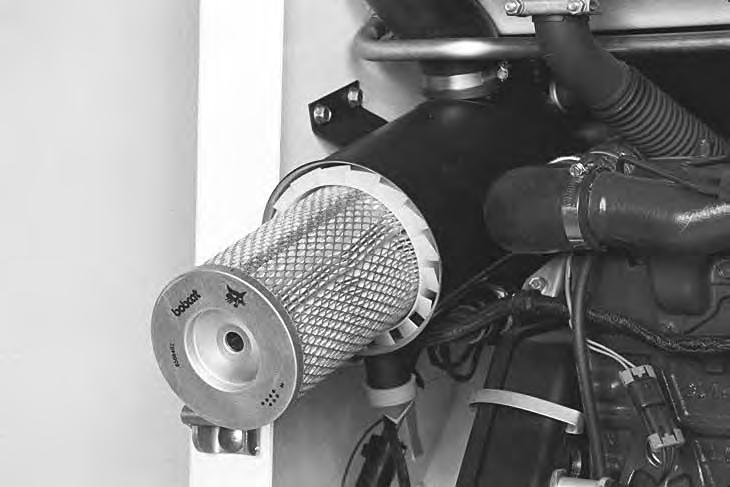
22 minute read
AIR CLEANER SERVICE
Replacing Filter Element
It is important to change the air filter element only when the Air Cleaner Icon in the right panel is ON (Item 1) [A] and you hear three beeps from the alarm.
Replace the inner filter every third time the outer filter is replaced or as indicated on page 51.
Press and hold the LIGHT Button (Item 1) [B] for two seconds.
If the filter element needs replacement, theCODE [01–17] (Air Filter Plugged) will show in the HOURMETER / CODE DISPLAY (Item 2) [B]
Outer Filter
Remove the wing nut and remove the dust cover [C]
Remove the wing nut and remove the outer filter element (Item 1) [D].

NOTE:Make sure all sealing surfaces are free of dirt and debris.
Install a new outer element.
Install the dust cover and the wing nut [C]
Check the air intake hose and the air cleaner housing for damage. Make sure all connections are tight.
AIR CLEANER SERVICE (Cont’d)
Replacing Filter Element (Cont’d) Inner Filter
Only replace the inner filter element (Item 1) [A] under the following conditions:
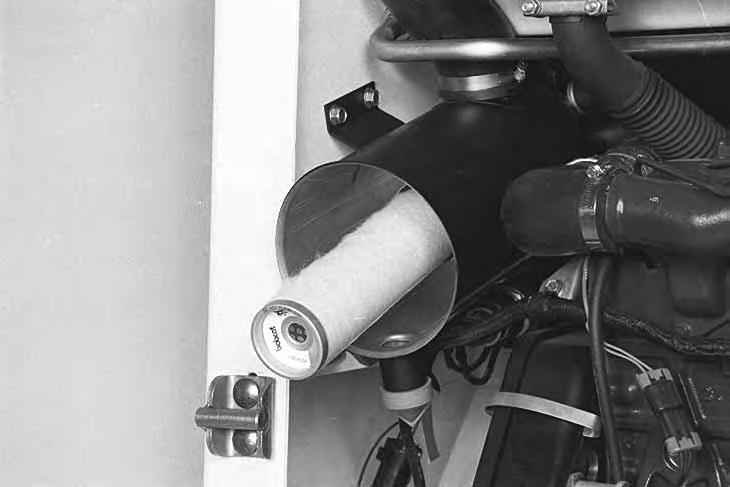
8.
• Replace the inner filter element everythird time the outer filter is replaced.
• After the outer element has been replaced, start the engine and run at full RPM. If the HOURMETER / CODE DISPLAY shows [ 01–17] (Air Filter Plugged), replace the inner filter element.
Remove the wing nut and remove the inner filter element (Item 1) [A]
9.
NOTE:Make sure all sealing surfaces are free of dirt and debris.
Install the new inner element.
Install the outer element.
Install the dust cover and the wing nut [B].

Fuel System
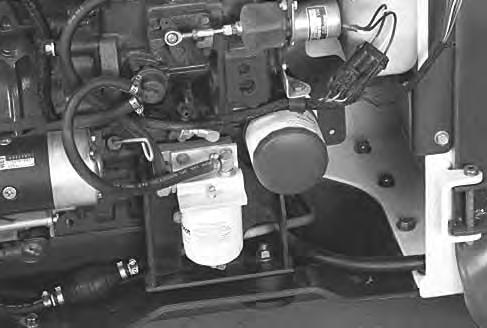
Fuel Specifications
Use only clean, high quality diesel fuel, Grade No. 2 or Grade No. 1.
The following is one suggested blending guideline which should prevent fuel gelling problems:
Temp. F° (C°)No. 2No.1
+15°(9°)100%0%
Down to –20° (–29°)50% 50%
Below –20° (29°) 0% 100%
See your fuel supplier for local recommendations.
Filling The Fuel Tank
Stop and cool the engine before adding fuel. NO SMOKING! Failure to obey warnings can cause an explosion or fire.
W–2063–0887
Remove the fuel fill cap (Item 1) [A]
Use a clean, approved safety container to add fuel of the correct specifications. Add fuel only in an area that hasfree movement of air and no open flames or sparks. NO SMOKING! [B]
Install and tighten the fuel fill cap [A]
Fuel Filter
See the SERVICE SCHEDULE Page 39 for the service interval when to remove the water from the fuel filter.
Loosen the drain (Item 1) [C] at the bottom of the filter element to drain water from the filter.
See the SERVICE SCHEDULE Page 39 for the service interval when to replace the fuel filter.
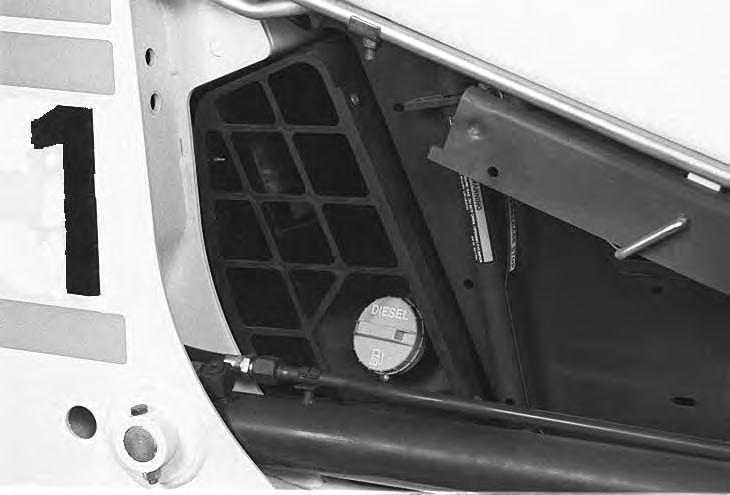
Remove the filter element (Item 2) [C].
Clean the area around the filter housing.
Put oil on the seal of the new filter element.
Install the fuel filter, and hand tighten.
Remove the air from the fuel system. (See Removing Air From the Fuel System Page 53.)
W–2103–1285
FUEL SYSTEM (Cont’d) Removing Air From The Fuel System 10.
After replacing the fuel filter element or when the fuel tank has run out of fuel, the air must be removed from the fuel system before starting the engine.
Diesel fuel or hydraulic fluid under pressure can penetrate skin or eyes, causing serious injury or death. Fluid leaks under pressure may not be visible. Use a piece of cardboard or wood to find leaks. Do not use your bare hand. Wear safety goggles. If fluid enters skin or eyes, get immediate medical attention from a physician familiar with this injury.
Open the fuel filter vent (Item 1) [A]
Operate the hand pump (priming bulb) (Item 2)[A] until fuel flows from the vent with no air bubbles.
Close the fuel filter vent (Item 1) [A]
Open the injection pump vent (Item 3) [A]
Operate the hand pump (priming bulb) (Item 2)[A] until the pump feels solid.
Tighten the injection pump vent (Item 3) [A]
Start the engine. It may be necessary to open the vent plug (at the fuel injection pump) briefly until the engine runs smoothly.

ENGINE LUBRICATION SYSTEM
11.
Checking Engine Oil
Check the engine oil level every day before starting the engine for the work shift.
Open the rear door and remove the dipstick (Item 1) [A].
Keep the oil level between the marks on the dipstick. Use a good quality motor oil that meets API Service Classification of CD or better (See Oil Chart below).
Oil Chart
RECOMMENDED SAE VISCOSITY NUMBER (LUBRICATION OILS FOR DIESEL ENGINE CRANKCASE)
° –34–29–23–18–13–7–1+4+10+15+21+27+32+38+43+49
SAE 10W–30
SAE 15W–40
SAE 40W or 20W–50
SAE 30W
* SAE 5W–30
SAE 20W–20
SAE 10W
SYNTHETIC OIL Use recommendation from Synthetic Oil Mfgr.
° –30–20–100+10+20+30+40+50+60+70+80+90+100+110+120
TEMPERATURE RANGE ANTICIPATED BEFORE NEXT OIL CHANGE (DIESEL ENGINES MUST USE API CLASSIFICATION CD, CF4, CG4 ) * Can be used ONLY when available with appropriate diesel rating.
Replacing Oil And Filter
See the SERVICE SCHEDULE Page 39 for the service interval for replacing the engine oil and filter. Run the engine until it is at operating temperature. Stop the engine.
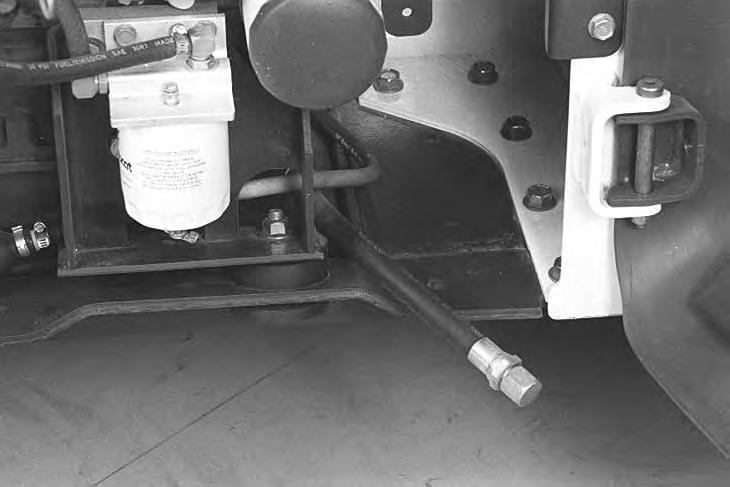

Open the rear door.
Remove the drain plug (Item 1) [B]
Drain the oil into a container and recycle or dispose of used oil in an environmentally safe manner.
N–20587
ENGINE LUBRICATION SYSTEM (Cont’d)
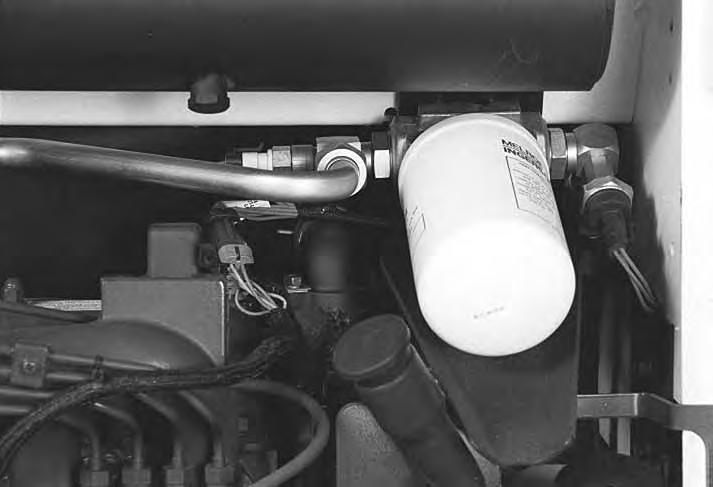
Replacing Oil And Filter (Cont’d)
Remove the oil filter (Item 1) [A]
Clean the filter housing surface.
Put clean oil on the new oil filter gasket.
Install the filter and hand tighten.
Install and tighten the drain plug.
Remove the filler cap (Item 1) [B]
Put oil in the engine. (See SPECIFICATIONS Page 89, for Capacity) [B]. (See Oil Chart, Page 54.)
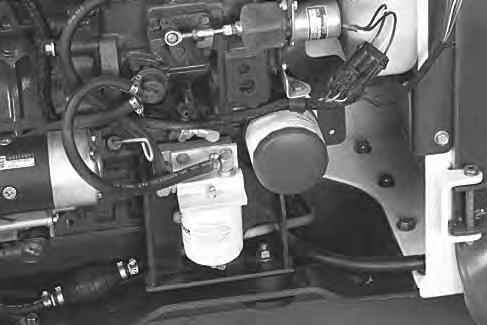
Start the engine and let it run for several minutes.
Stop the engine.
Check for leaks at the oil filter and check the oil level.
Add oil as needed if it is not at the top mark (Item1) [C] on the dipstick.
Always clean up spilled fuel or oil. Keep heat, flames, sparks or lighted tobacco away from fuel and oil. Failure to use care around combustibles can cause explosion or fire which can result in injury or death.
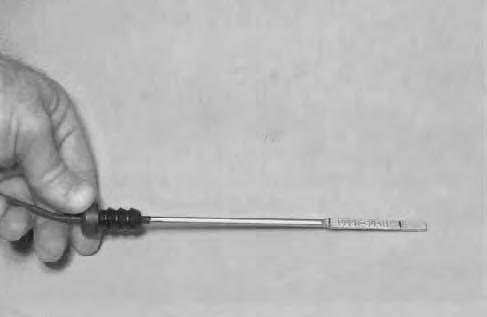
ENGINE
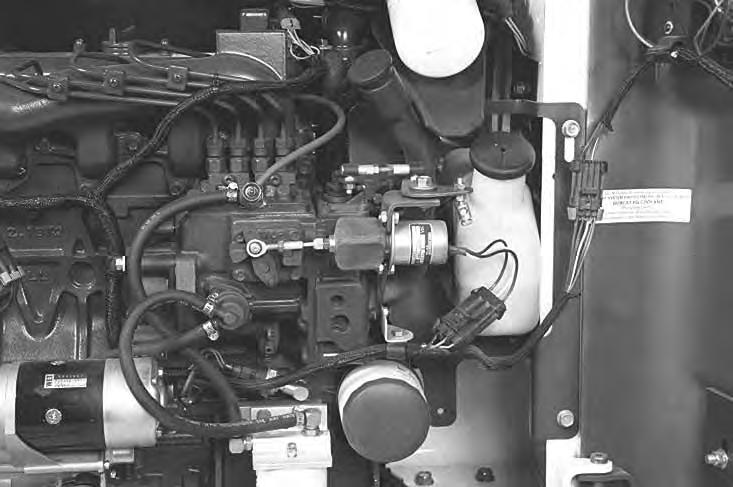
Cooling System
Check the cooling system every day to prevent over–heating, loss of performance or engine damage.
Wear safety glasses to prevent eye injury when any of the following conditions exist:
• When fluids are under pressure.
• Flying debris or loose material is present.
• Engine is running.
• Tools are being used.
W–2019–1285
Cleaning The Cooling System
Raise the rear grill.
Use air pressure or water pressure to clean the top of the oil cooler [A]

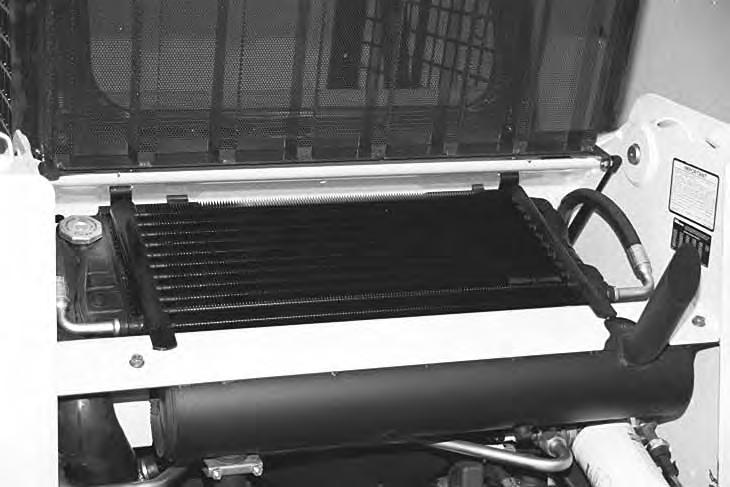
Raise the oil cooler and clean the top of the radiator [B]
Check cooling system for leaks.
Checking The Coolant Level
Open the rear door.
Check the coolant level in the coolant recovery tank (Item 1) [C].
The coolant level must be between the MIN and MAX marks on the coolant recovery tank when the engine is cold.
Avoid Engine Damage
Always use the correct ratio of water to antifreeze.
Too much antifreeze reduces cooling system efficiency and may cause serious premature engine damage.
Too little antifreeze reduces the additives which protect the internal engine components; reduces the boiling point and freeze protection of the system.
Always add a premixed solution. Adding full strength concentrated coolant can cause serious premature engine damage.
I–2124–0497
ENGINE COOLING SYSTEM (Cont’d) Replacing The Coolant
Do not remove radiator cap when the engine is hot. You can be seriously burned.
W–2070–1285
Open the rear door. Open the rear grill.
Remove the radiator cap (Item 1) [A]
Connect a hose to the engine block drain valve (Item 1)[B]
Open the drain valve and drain all of the coolant into a container. Dispose of used coolant in an environmentally safe manner.
Close the drain valve.
Mix the coolant in a separate container. (See SPECIFICATIONS Page 89, for correct capacity.)
NOTE:The loader is factory filled with propylene glycol coolant (purple color). DO NOT mix propylene glycol with ethylene glycol.
Add premixed coolant, 47% water and 53% propylene glycol to the recovery tank if the coolant level is low.
One gallon and one pint (4,3 L) of propylene glycol mixed with one gallon (3,8 L) of water is the correct mixture of coolant to provide a –34°F (–37°C) freeze protection. Use a refractometer to check the condition of propylene glycol in your cooling system.

Fill the radiator with the premixed coolant. Install the radiator cap.
Add coolant to the recovery tank. The coolant level must be between the MIN and MAX marks on the coolant recovery tank.
Run the engine until it is at operating temperature.
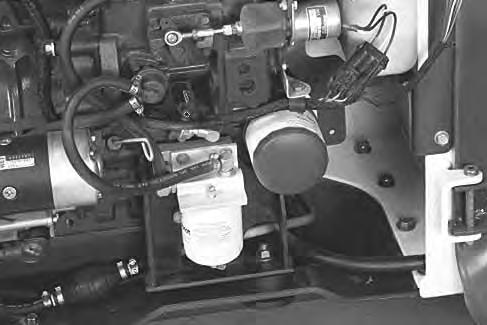
Stop the engine.
Check the coolant level in the recovery tank when cool. Add coolant to the recovery tank as needed.
Avoid Engine Damage
Always use the correct ratio of water to antifreeze.
Too much antifreeze reduces cooling system efficiency and may cause serious premature engine damage.
Too little antifreeze reduces the additives which protect the internal engine components; reduces the boiling point and freeze protection of the system.
Always add a premixed solution. Adding full strength concentrated coolant can cause serious premature engine damage.
Alternator Belt
Adjusting
Stop the engine.
Raise the operator cab. (See Raising The Operator Cab Page 42.)
Loosen the alternator mounting bolt (Item 1) [A]
Loosen the adjustment bolt (Item 2) [A].
Move the alternator until the belt has 5/16 inch (8,0 mm) movement at the middle of the belt span with 15 lbs. (66 Nm) of force.
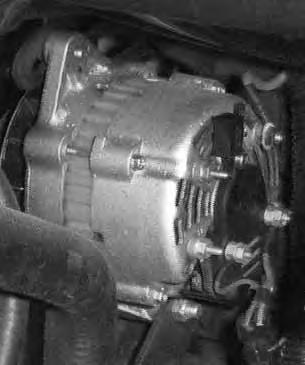
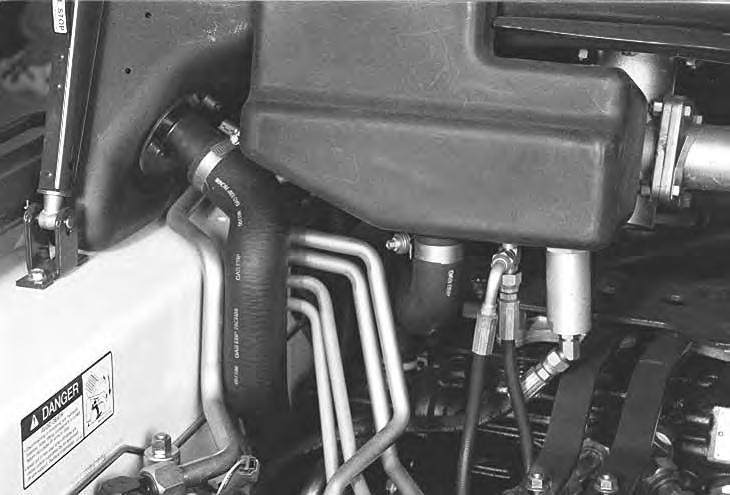
Tighten the adjustment bolt and mounting bolt.
Lower the operator cab.
ELECTRICAL SYSTEM Description
The loader has a 12 volt, negative ground alternator charging system. The electrical system is protected by fuses located in the cab on the steering control panel, and a 100 amp. master fuse (Inset) [A] in the engine compartment on the left side of the engine. The fuses will protect the electrical system when there is an electrical overload. The reason for the overload must be found before starting the engine again.
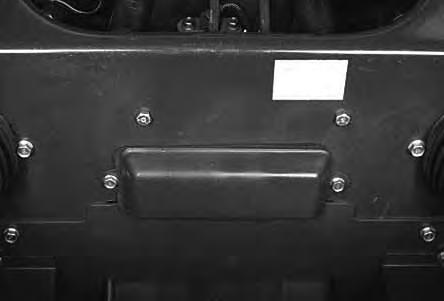
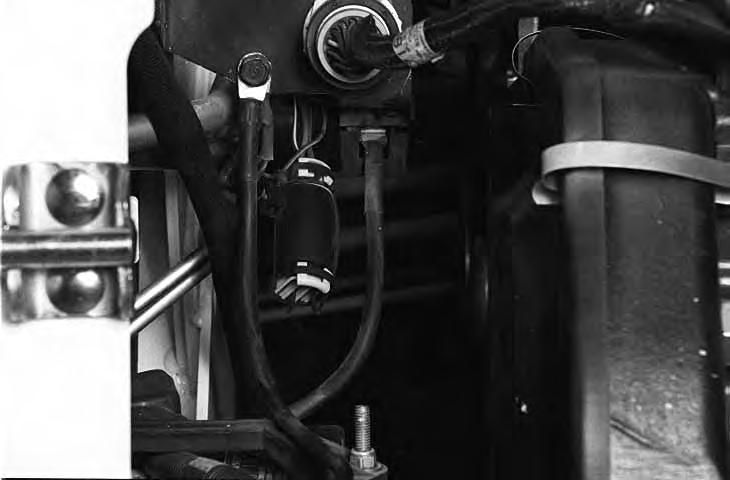
Cleaning Battery Terminals
The battery cables must be clean and tight. Check the electrolyte level in the battery. Add distilled water as needed. Remove acid or corrosion from the battery and cables with a sodium bicarbonate and water solution.
Put Battery Saver P/N 6664458 or grease on the battery terminals and cable ends to prevent corrosion.
Batteries contain acid which burns eyes and skin on contact. Wear goggles, protective clothing and rubber gloves to keep acid off body.
In case of acid contact, wash immediately with water. In case of eye contact get prompt medical attention and wash eye with clean, cool water for at least 15 minutes.
If electrolyte is taken internally drink large quantities of water or milk! DO NOT induce vomiting. Get prompt medical attention.
W–2065–1296
Fuse Location
The electrical system is protected from overload by fuses and relays under the fuse panel cover (Item 1)[B]. A decal is inside the cover to show location and amp ratings. Remove the cover to check or replace the fuses.
The location and sizes are shown below and [C].

ELECTRICAL SYSTEM (Cont’d)
Using A Booster Battery (Jump Starting)
If it is necessary to use a booster battery to start the engine, BE CAREFUL! There must be one person in the operator’s seat and one person to connect and disconnect the battery cables.
The key switch must be OFF (Standard Panel) OR the STOP Button must be pressed (Deluxe Panel). The booster battery must be 12 volt.
Damage to the alternator can occur if:
• Engine is operated with battery cables disconnected.
• Battery cables are connected when using a fast charger or when welding on the loader (Remove both cables from the battery).
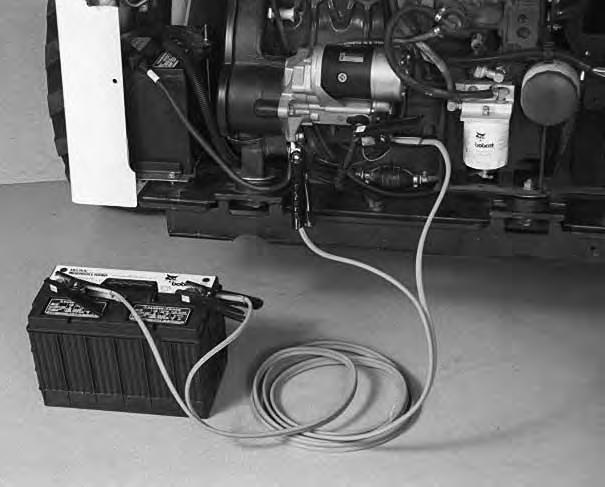
• Extra battery cables (booster cables) are connected wrong.
Batteries contain acid which burns eyes and skin on contact. Wear goggles, protective clothing and rubber gloves to keep acid off body.
In case of acid contact, wash immediately with water. In case of eye contact get prompt medical attention and wash eye with clean, cool water for at least 15 minutes.
If electrolyte is taken internally drink large quantities of water or milk. DO NOT induce vomiting. Get prompt medical attention.
W–2065–1296
Keep arcs, sparks, flames and lighted tobacco away from batteries. When jumping from booster battery make final connection (negative) at engine frame.
Do not jump start or charge a frozen or damaged battery. Warm battery to 60oF. (16oC.) before connecting to a charger. Unplug charger before connecting or disconnecting cables to battery. Never lean over battery while boosting, testing or charging.
Battery gas can explode and cause serious injury.
W–2066–1296
Connect the end of the first cable (Item 1)[A] to the positive (+) terminal of the booster battery. Connect the other end of the same cable (Inset–Item 2)[A] to the positive terminal on the loader starter.
Connect the end of the second cable (Item 3) [A] to the negative (–) terminal of the booster battery. Connect the other end of the same cable (Inset–Item 4) [A] to the engine.
Keep cables away from moving parts. Start the engine. (See STARTING THE ENGINE, Page 18.)
After the engine has started, remove the ground (–) cable (Item 4) [A] first.
Remove the cable from the positive terminal (Item 2) [A]
ELECTRICAL SYSTEM (Cont’d)
Removing And Installing The Battery
Batteries contain acid which burns eyes and skin on contact. Wear goggles, protective clothing and rubber gloves to keep acid off body.
In case of acid contact, wash immediately with water. In case of eye contact get prompt medical attention and wash eye with clean, cool water for at least 15 minutes.
If electrolyte is taken internally drink large quantities of water or milk! DO NOT induce vomiting. Get prompt medical attention.
W–2065–1296
Open the rear door.
Disconnect the negative (–) battery cable (Item 1) [A].
Remove the battery hold down clamp (Item 2) [A].
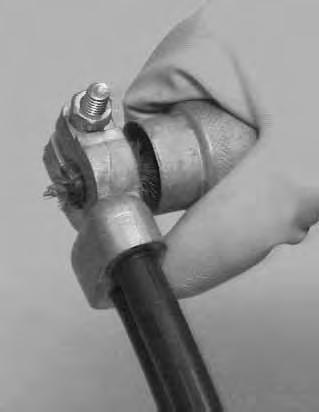
Disconnect the positive (+) battery cable (Item 1) [B].
Remove the battery from the loader.
Always clean the battery terminals and cable ends when installing a new or used battery [C]
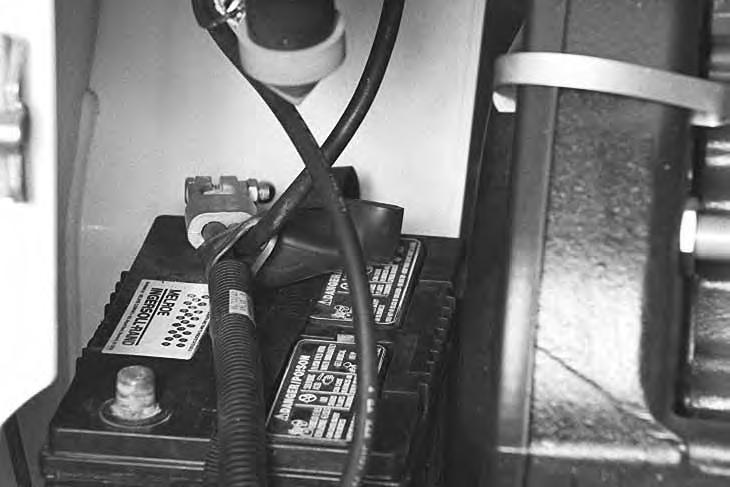
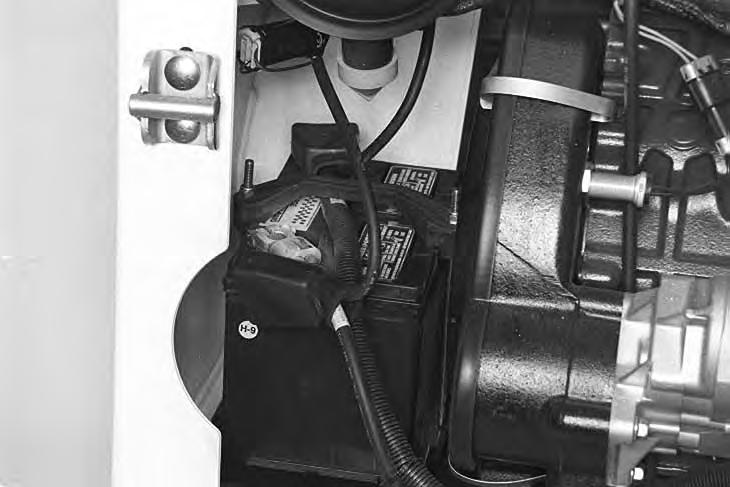
When installing the battery in the loader, do not touch any metal parts with the battery terminals.

Connect the negative (–) cable last to prevent sparks.Connect and tighten the battery cables.
Close the rear door before operating the loader.
HYDRAULIC/HYDROSTATIC SYSTEM
Checking And Adding Fluid
Use only recommended fluid in the hydraulic system. (See SPECIFICATIONS Page 89.)
Stop the loader on a level surface. Lower the lift arms and tilt the Bob–Tach fully back.

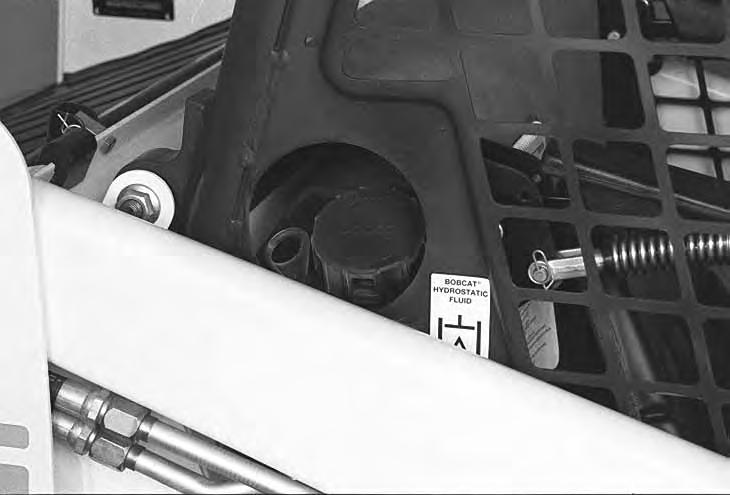
Stop the engine.
Remove the dipstick (Item 1) [A]. Check the fluid level.
Remove the fill cap (Item 2) [A]
Add the fluid as needed to bring the level to the top mark on the dipstick [B]. Do not fill above the top mark.

Remove the screen [C] & clean with solvent as needed. Install the fill cap.
Replacing Hydraulic/Hydrostatic Filter 12.
See the SERVICE SCHEDULE Page 39 for the correct service intervals.
Open the rear door.
Remove the filter element (Item 1) [D].
Clean the surface of the filter housing where the seal contacts the housing.
Put clean oil on the seal of the new filter element.
Install and hand tighten the filter element. Close the rear door before operating the loader.

HYDRAULIC/HYDROSTATIC SYSTEM (Cont’d)
Replacing Hydraulic Fluid and Case Dain Filters
See the SERVICE SCHEDULE Page 39, for the service interval.
The fluid must be replaced if it becomes contaminated or after major repairs. If the fluid is replaced, the hydrostatic filter and both case drain filters must be replaced.
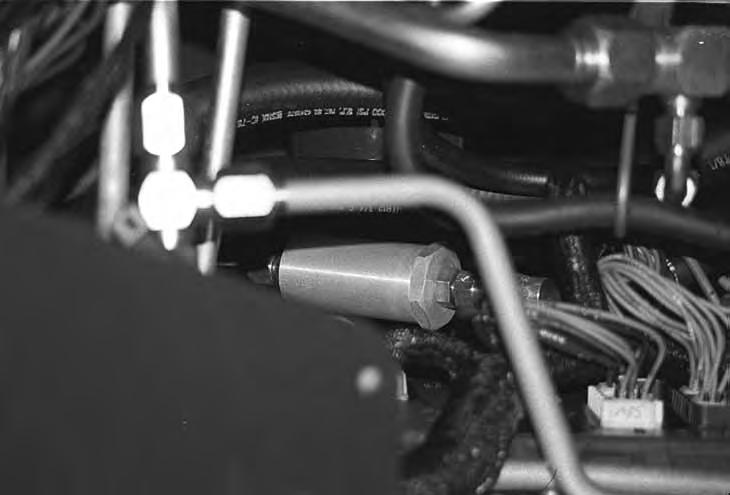
Remove the reservoir fill cap (Item 1) [A]
Raise the operator cab. (See Raising The Operator Cab Page 42.)
Disconnect the hose (Item 1) [B] from the case drain filter located on the reservoir. Use a cap on the hose to prevent leakage.
Remove the case drain filter (Item 2)[B]. Drain the fluid into a container.
Drain the fluid into a container and recycle or dispose in an environmentally safe manner.
Remove the left case drain filter (Item 1) [C] and drain the fluid into a container.
Recycle or dispose of the fluid in an environmentally safe manner.
Replace the hydraulic/hydrostatic filter element. (See Page 62.)
Install new hydrostatic motor case drain filters (Item 2) [B] & (Item 1) [C] and reconnect the hoses.
Add the correct fluid to the reservoir until the fluid level is between the marks on the dipstick. DO NOT fill above the top mark on the dipstick.

Hydraulic fluid escaping under pressure can have sufficient force to enter a person’s body by penetrating the skin and cause serious injury and possibly death if proper medical treatment by a physician familiar with this injury is not received immediately.
W–2145–0290
Always clean up spilled fuel or oil. Keep heat, flames, sparks or lighted tobacco away from fuel and oil. Failure to use care around combustibles can cause explosion or fire which can result in injury or death.
W–2103–1285
Lower the operator cab (See Lowering the Operator Cab Page 43.)
Start the engine and operate the loader hydraulic controls. Stop the engine and check for leaks.
Check the fluid level in the reservoir and add as needed.

HYDRAULIC/HYDROSTATIC SYSTEM (Cont’d)
Breather Cap
See the SERVICE SCHEDULE Page 39, for the correct service interval.
Raise the cab (See Raising The Operator Cab Page 42.).
Remove the breather cap (Item 1) [A]
Clean the filter (Item 1) [B] in the breather cap.
NOTE:Be sure the rubber gasket (Item 2) is installed on the cap and the baffle washer (Item 3) [B] is installed over the opening of the hydraulic reservoir.
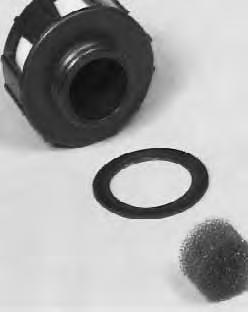

Install the breather cap.
Lower the cab (See Lowering The Operator Cab Page 43).

Spark Arrestor Muffler
See the SERVICE SCHEDULE, Page 39 for service interval for cleaning the spark arrestor muffler.
Do not operate the loader with a defective exhaust system.
This loader is factory equipped with a U.S.D.A. Forestry Service approved spark arrestor muffler. It is necessary to do maintenance on this spark arrestor muffler to keep it in working condition. The spark arrestor muffler must be serviced by dumping the spark chamber every 100 hours of operation.
If this machine is operated on flammable forest, brush or grass covered land, it must be equipped with a spark arrestor attached to the exhaust system and maintained in working order. Failure to do so will be in violation of California State Law, Section 4442 PRC.
Make reference to local laws and regulations for spark arrestor requirements.
I–2022–0595
Stop the engine. Open the rear door and raise the rear grill. Remove the plug (Item 1) [A] from the bottom of the muffler.
N–18435
When an engine is running in an enclosed area, fresh air must be added to avoid concentration of exhaust fumes. If the engine is stationary, vent the exhaust outside. Exhaust fumes contain odorless, invisible gases which can kill without warning.

W–2050–1285
Stop engine and allow the muffler to cool before cleaning the spark chamber. Wear safety glasses or goggles. Failure to obey can cause serious injury.
W–2011–1285
Never use machine in atmosphere with explosive dust or gases or where exhaust can contact flammable material. Failure to obey warnings can cause injury or death.
W–2068–1285
When the engine is running during service, the steering levers must be in neutral and the parking brake engaged. Failure to do so can cause injury or death.
W–2006–0284
Start the engine and run for about 10 seconds while a second person, wearing safety glasses, holds a piece of wood over the outlet of the muffler.
This will force contaminants out through the cleanout hole. Stop the engine.
Install and tighten the plug.
Lower the rear grill and close the rear door.
Tire Maintenance
Wheel Nuts
See the SERVICE SCHEDULE Page 39, for the service interval to check the wheel nuts. The correct torque is 105–115 ft.–lbs. (142–156 Nm) torque [A].
Rotating
Check the tires regularly for wear, damage and pressure. (See SPECIFICATIONS Page 89 for the correct tire pressure.)
Rear tires usually wear faster than front tires. To keep tire wear even, move the front tires to the rear and rear tires to the front [B]
It is important to keep the same size tires on each side of the loader. If different sizes are used, each tire will be turning at a different rate and cause excessive wear. The tread bars of all the tires must face the same direction.

Recommended tire pressure must be maintained to avoid excessive tire wear and loss of stability and handling capability. Check for the correct pressure before operating the loader.
Mounting
Tires are to be repaired only by an authorized person using the proper procedures and safety equipment.
Tires and rims must always be checked for correct size before mounting. Check rim and tire bead for damage.
The rim flange must be cleaned and free of rust. The tire bead and rim flange must be lubricated with a rubber lubricant before mounting the tire. Avoid excessive pressure which can rupture the tire and cause serious injury or death.
During inflation of the tire, check the tire pressure frequently to avoid over inflation.
Do not inflate tires above specified pressure. Failure to use correct tire mounting procedure can cause an explosion which can result in injury or death.
FINAL DRIVE TRANSMISSION (CHAINCASE) Checking And Adding Oil
The chaincase contains the final drive sprockets and chains. Use the same type of oil as the hydraulic/hydrostatic system. (See SPECIFICATIONS Page 89.)

Stop the loader on a level surface.

Stop the engine.
Remove the plug (Item 1) [A] from the front of the chaincase housing.
If oil can be reached with the tip of the your finger through the hole, the oil level is correct.
If the level is low, add oil through the check plug hole until the oil flows from the hole.
Install and tighten the plug.
Removing Oil From The Chaincase
Remove the cover (Item 1) [B] which is installed over the drain plug at the bottom rear of the chaincase.
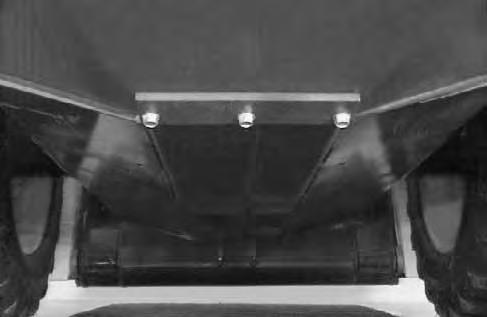
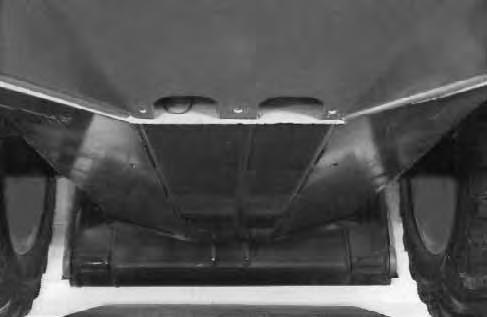
Remove the drain plug (Item 1) [C] and drain the oil into a container. Recycle or dispose of the used oil in an environmentally safe manner.
Check the drain plug and replace as necessary.
Fan Gearbox
See the SERVICE SCHEDULE Page 39, for the correct service interval.
Checking And Maintaining
Raise the operator cab. (See Raising The Operator Cab Page 42).
Remove the plug (Item 1) [D] to check the lubricant level.
If the level is low, add SAE 90W gear lubricant through the check plug hole until lubricant flows from the hole.
Install and tighten the plug.
Lower the operator cab. (See Lowering the Operator Cab Page 43.)
Drive Belt
Adjusting The Drive Belt
Stop the engine.
Open the rear door and disconnect the negative (–) cable from the battery.
Remove three belt shield fasteners and remove the belt shield.
Loosen the bolt (Item 1)[A] on the spring loaded drive idler.
NOTE:The pointer will be at the 1 o’clock position (Item 2) [A] when the belt tensioner is not under spring tension.
Push the idler pulley against the belt, using a pry bar [B]. The pointer will be at the 3 o’clock position (Item 1) [B] when the idler pulley is against the stop (maximum movement)
Raise the idler assembly slightly so that the pulley is operating on spring tension and not against the stop.
NOTE:Do not set the idler against the travel stop in the 3 o’clock position.
Tighten the mounting bolt (Item 1) [A] to 25–28 ft.lbs. (34–38 Nm) torque.
Run the engine for a few minutes. Stop the engine and recheck the pointer position.
Readjust if necessary.
After the idler has been in service, readjust when the pointer reaches the 1 o’clock position.
Install the belt shield and fasteners.
Connect the negative (–) battery cable.
Close the rear door.
Replacing The Drive Belt
Follow the steps above to loosen the drive belt tensioner.

Remove the bolt (Item 1) [A] from the tensioner and remove the tensioner assembly.
Remove the fan drive belt.
Remove the drive belt from the pump pulley and flywheel and remove the belt from the loader.
Install the new drive belt. Install the belt tensioner assembly.
Install the fan drive belt.
Adjust the drive belt, reinstall previously removed components and continue procedure from Adjusting The Drive Belt above.)
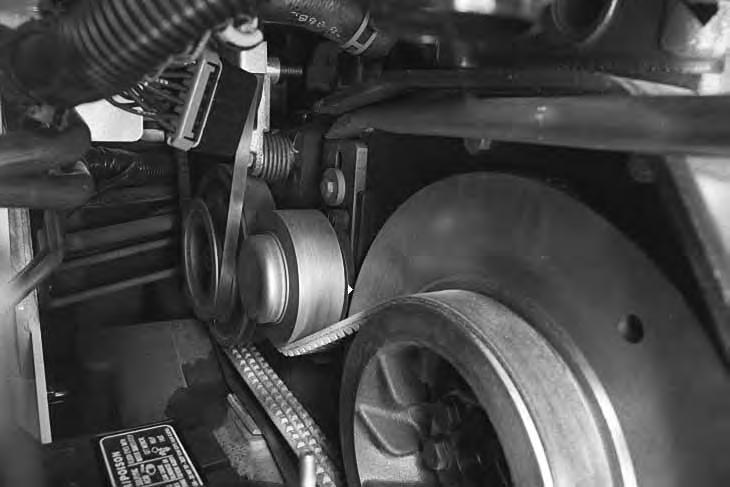
Lubrication Of The Bobcat Loader
13.
Lubricate the loader as specified in the SERVICE SCHEDULE Page 39 for the best performance of the loader.

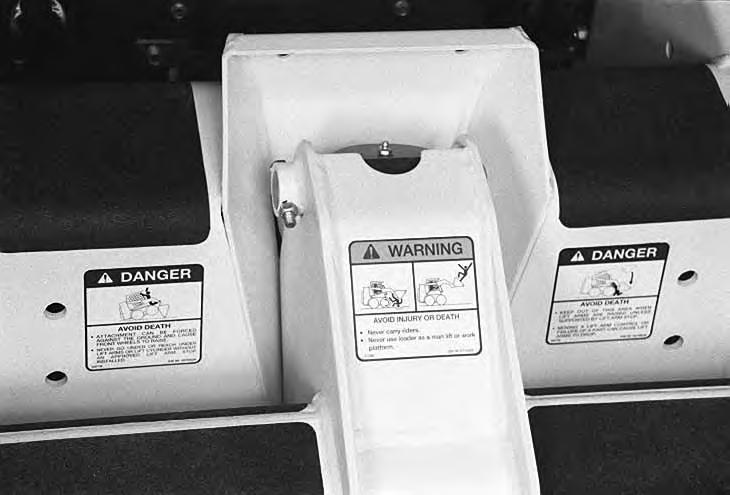
Record the operating hours each time you lubricate the Bobcat loader.
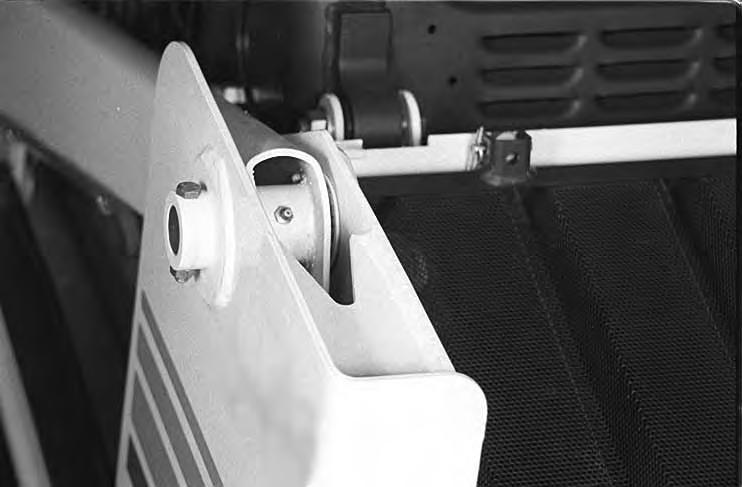
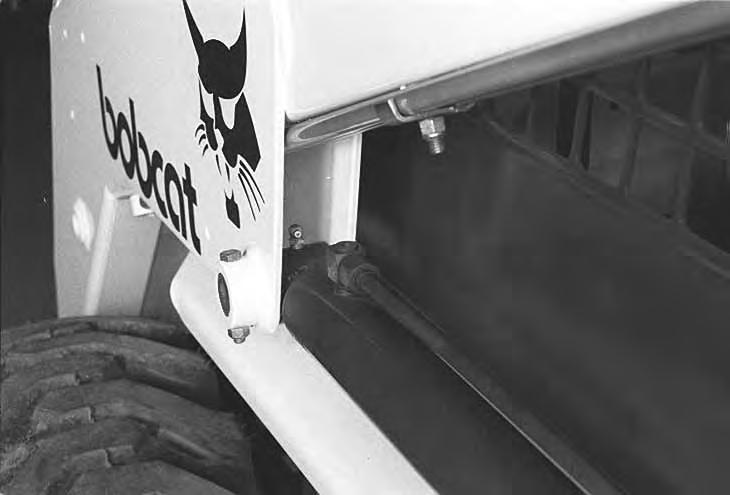
Always use a good quality lithium based multi–purpose grease. Apply lubricant until extra grease shows.
Lubricate the following locations on the loader:
LUBRICATION OF THE BOBCAT LOADER (Cont’d)
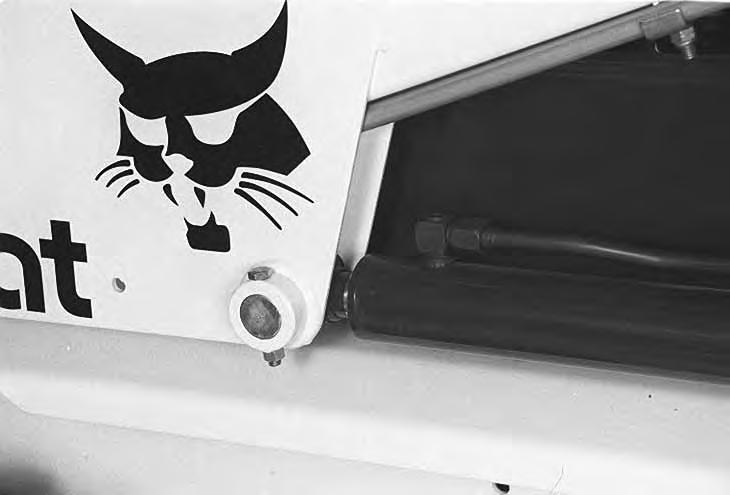
5.Rod End Tilt Cylinder [A].
6.Bob–Tach Pivot Pin (Both Sides) [B]
7.Bob–Tach Wedge (Both Sides) [B].
8.250 Hours: Steering Lever Shaft (2) [C]

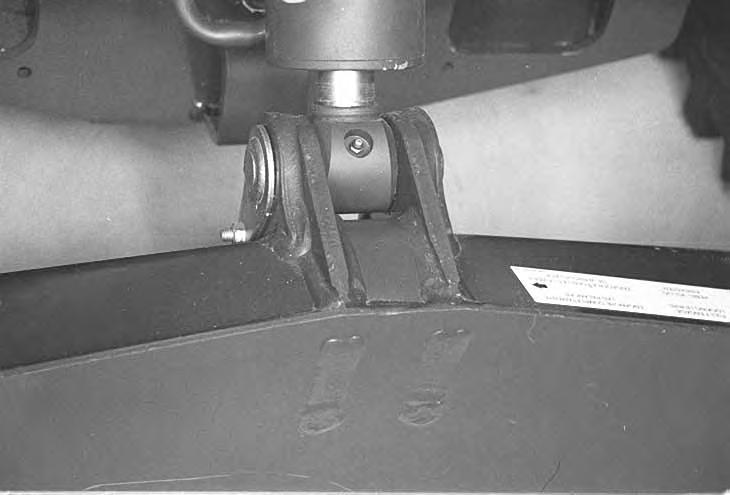
PIVOT PINS
All lift arm and cylinder pivots have a large pin held in position with a retainer bolt and lock nut (Item 1) [D].
Check that the lock nuts are tightened to 18–20 ft.–lbs. (24–27 Nm) torque.

BOB–TACH Inspection and Maintenance
Move the Bob–Tach levers to engage the wedges[A]. The levers and wedges must move freely.
The wedges must extend through the holes in the attachment mounting frame (Item 1) [A].
Bob–Tach wedges must extend through the holes in attachment. Levers must be fully down and locked. Failure to secure wedges can allow attachment to come off and cause injury or death.
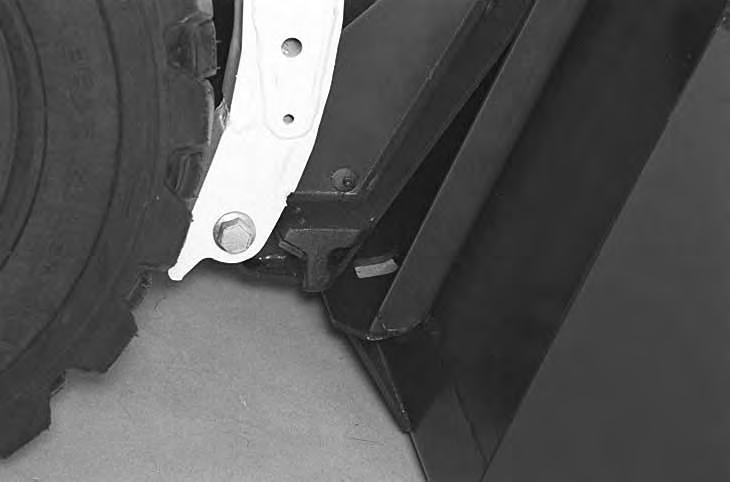
W–2102–0588
The spring loaded wedge (Item 1) [A] must contact the lower edge of the hole in the attachment (Item 1) [B] and [C].
If the wedge does not contact the lower edge of the hole[B] and [C], the attachment will be loose and can come off the Bob–Tach.
Bob–Tach Wedge
Wedge Must Contact Lower Edge Of Hole In The Attachment
Inspect the mounting frame on the attachment and the Bob–Tach, linkages and wedges for excessive wear or damage [D]. Replace any parts that aredamaged, bent, or missing. Keep all fasteners tight.
Look for cracked welds. Contact your Bobcat dealer for repair or replacement parts.
Lubricate the wedges (See SERVICE SCHEDULE, Page 39 and LUBRICATION OF THE BOBCAT LOADER, Page 69).
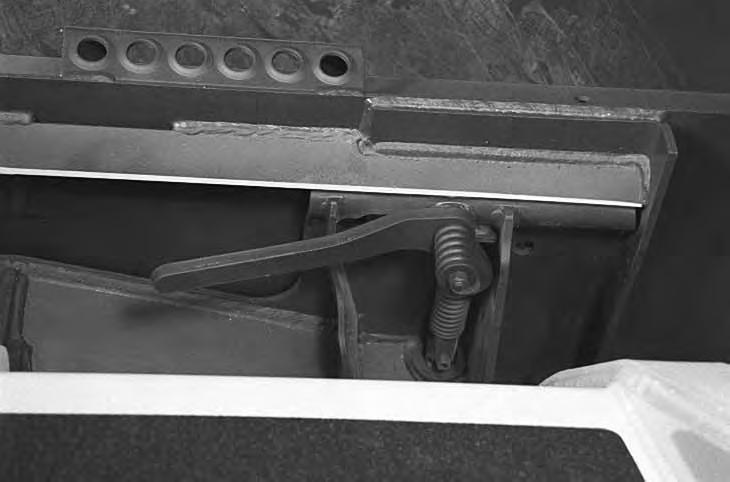


BOBCAT INTERLOCK CONTROL SYSTEM (BICS™)
Troubleshooting Chart 10.
The following chart shows the effects which can happen to the loader, and the probable causes when the BICS Instrument Panel lights are off. See [A] for location of BICS lights and Icons. Have service procedures performed ONLY BY QUALIFIED BOBCAT SERVICE PERSONNEL.
Press and hold LIGHTS Button (Item 5)[A] for two seconds to view SERVICE CODES in the HOURMETER / CODE DISPLAY (Item 6) [A]. If more than one SERVICE CODE is present, the codes will scroll on the HOURMETER / CODE DISPLAY.
Indicator Light Light ONLight OFF
PRESS TO OPERATE LOADER Button is pressed.
PRESS TO OPERATE LOADER Button is not pressed.
Effect on Operation of Loader When Light is OFF
Lift, tilt and traction functions will not operate.
NOTES: Multiple SERVICE CODES and/or Abnormal Symptoms can be caused by corroded or loose ground. Check grounds and both battery connections.
ERROR OFF = shorted to ground or bad fuse, faulty wiring, faulty open relay, no voltage from relay to controller. ERROR ON = shorted to battery voltage, faulty wiring, faulty closed relay.
* Normal BICS operating voltage is less than the electrical system voltage.
SERVICE CODE Means System Error (See Your Bobcat Dealer for Service)
Causes Service Code
Seat Bar is down. Seat Bar is up.Lift and tilt functions will not operate.
Seat Bar sensor circuit shorted to battery voltage*
Seat Bar sensor circuit shorted to ground
Control valve can be used. Control valve cannot be used. Lift, tilt and traction functions will not operate.
217–05 317–06
Valve output circuit is open.
Valve output circuit shorted to battery voltage*
Valve output circuit shorted to ground
Controller not grounded or intermittent ground. 317–06
Loader can be moved forward & backward.
Loader cannot be moved forward and backward.
Loader cannot be moved forward and backward.
Traction lock hold solenoid circuit is open.
Traction lock hold solenoid circuit shorted to battery voltage*
Traction lock hold solenoid circuit shorted to ground.
Traction lock pull solenoid circuit is shorted to battery voltage* – ERROR ON (Should be OFF) 515–02
Traction lock pull solenoid circuit ERROR OFF (Should be ON)
Deluxe Instrumentation Service Codes
The hourmeter display on the Left Instrument Panel can change from engine hours to SERVICE CODES (See at right.). These CODES help your dealership analyze monitored functions of your Bobcat loader. Some service procedures must be performed ONLY BY QUALIFIED BOBCAT SERVICE PERSONNEL.
Press and hold LIGHTS Button (Item 5)[A] (Page 75) for two seconds to view SERVICE CODES in the HOURMETER / CODE DISPLAY display (Item 6) [A] (Page 75). If more than one SERVICE CODE is present, the codes will scroll on the HOURMETER / CODE DISPLAY.
The following word errors may also be displayed:
REPLY One or both instrument panel(s) not communicating with the controller.
INPUT The controller not communicating with the left instrument panel.
The Prefix, in the left two columns, followed by a Suffix, in the right two columns, will indicate a Function Error.
EXAMPLE: 01–17 Plugged Air Filter
Prefixfunction
01Air Filter
02Hydraulic Charge Filter
03Battery Voltage
04Engine Oil Pressure
05Hydraulic Charge Pressure
06Engine Speed
07Hydraulic Oil Temperature
08Engine Coolant Temperature
09Fuel Level
11Seat Bar Sensor
CODE The controller is asking for a password. (Deluxe Panel Only)
ERROR The wrong password was entered. (Deluxe Panel Only)
Service Codes
Suffixerror Description
02Error ON (Detects ON when should be OFF)
03Error OFF (Detects OFF when should be ON)
04In Error
05Short To Battery (Detects 12V & should not be)
06Short To Ground
07Open Circuit (Not grounded)
09Low
10High
11Extremely High
13No Signal
12Front Auxiliary PWM Switch (Proportional Control)
13Fuel Shutoff Solenoid – Secondary
14Fuel Shutoff Solenoid – Primary
15Traction Lock Solenoid – Primary
16Traction Lock Solenoid – Secondary
17Lift and Tilt Valve Solenoid
18Spool Lock Solenoid
19Bucket Positioning Solenoid
21Glow Plugs
22Starter Output
23Solenoid for Rear Female Coupler
24Solenoid for Rear Male Coupler
25Rear Auxiliary Relief Solenoid
26Solenoid for Front Female Coupler
27Solenoid for Front Male Coupler
28Diverter Valve Solenoid
29High Flow Auxiliary Solenoid
31Recovery Mode Failure (Loss of Power)
32Advanced Hand Controls
33Constant Data (Stored Loader Information)
34Deluxe Panel Not Downgraded in Error
35Two Speed Fan
36 Attachment Control Device (ACD) Controller
80ACD Output A
81ACD Output B
82ACD Output C
83ACD Output D
84ACD Output E
85ACD Output F
86ACD Output G
87ACD Output H
14Extremely Low
15In Shutdown
16Not Connected
17Plugged
18Out Of Range
21Out Of Range High
(Above detectable range of sensor)
22Out Of Range Low
(Below detectable range of sensor)
23Not Calibrated
28Failure
31Tilt Actuator Fault
32Tilt Actuator Wiring Fault
33Tilt Handle Wiring Fault
34Tilt Actuator Not Calibrated
35Tilt Handle Not Calibrated
36Lift Actuator Fault
37Lift Actuator Wiring Fault
38Lift Handle Wiring Fault
39Lift Actuator Not Calibrated
40Lift Handle Not Calibrated
41Invalid Frequency From Advanced Hand Controls (AHC)
48Multiple Controllers Present – Error
Multiple SERVICE CODES and / or Abnormal Symptoms can be caused by corroded or loose ground connection. Flashing instrument panel lights, alarm beeping, front & rear lights flashing, low battery voltage, loose battery connectors, could also indicate a poor ground. Check all grounds before performing other diagnostics.
Deluxe Instrumentation Panel Setup
Deluxe Panel Upgrade
If you upgrade from a Standard Panel to a Deluxe Panel, press and hold the RUN/ENTER Button for at least 2 seconds to allow the system to recognize the upgrade. The home screen will then be displayed.
Icon Identification
Make selection by pressing SELECTION BUTTON opposite the Icon.
IconDescription
LOCK / UNLOCK: Allows machine to be locked / unlocked.
A valid password will need to be entered at startup to run a locked machine.
You must lock machine to activate security system.
TOOL / SETUP: Access system options.
Use to set clock, check system warnings, select language, set passwords, etc.
HELP: Access help on current menu item.
EXIT returns you to previous level menu.
CLOCK / JOB CLOCK: Press to clear or lock job clock; TOOL / SETUP to set time.
UP ARROW: Goes backward one screen.
DOWN ARROW: Goes forward one screen.
OUTLINE ARROWS: No screen available (backward / forward).
SELECTION ARROW: Use to select menu item.
NEXT INFO YES/NO CLEAR SET
Goes to the NEXT screen in series.
EXAMPLE: The next Active Warning screen. Goes to more information about an attachment.
Answer yes / no to current setup question. Removes previously installed password. Set accepts current installed password.
ADJUST CONTRAST SHORTCUT: Press either the left or right arrow keys to adjust the contrast lighter or darker.






